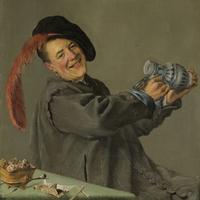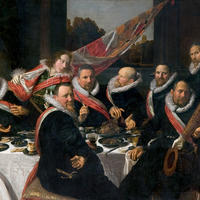More about Frans Hals Museum
Works at Frans Hals Museum

Contributor
Recently, the Frans Hals Museum merged its collection, which includes works by Jan Steen and Judith Leyster, as well as the largest group of Frans Hals works in the world, with a contemporary art museum a short walk away.
They could have done their best to keep old and new apart, like picky eaters pushing the gravy away from the cornbread, but they took the opposite approach, and grouped seemingly unrelated works of art together. In doing so, they brought a sense of excitement and surprise back to the museum world. Luckily, we're another step closer to moving past, or at least questioning, stodgy academic terms that only matter to a few "experts"— terms like "modern," "contemporary," "classical," "old master," "avant garde," and so on.
Slowly but surely, over the course of hundreds of years, European governments began to realize that it's probably better not to force one particular interpretation of the scriptures down everyone's throat. The idea of "religious freedom" comes from this movement, and I don't even have to tell you that it's a good thing. Before the idea of religious freedom in Europe, artists played the role of wizard-priests, wowing everyone with spectacular illustrations of miracles. Six hundred years ago, for example, no European would have said that an art gallery was "boring"—European art was - until the secularization of art, the opening of art markets, and the dawn of the age of art critics, curators, and historians - an enormous thrill, a sacred journey through time. Without imposing any system on us, the Frans Hals Museum is endeavoring to make art cool and current for museum-goers by imitating the experimental, risk-taking attitude of artists themselves. For Ann Demeester, director of the Frans Hals Museum, "an artist is more free" than an art historian "to connect" meaningful works across geography, language, and time.
Moving beyond the neurotic tendency of curators to group paintings by time period and culture, The Frans Hals Museum connects artworks to form surprising, unexpected relationships, like the juxtaposition of Kerry James Marshall's recent Untitled (Beauty Queen) with Frans Hals' Portrait of Cornelia Vooght from centuries earlier. This idea of switching up museum chronologies emerged, partly, from the tendency of art historians to overlook Hals in favor of Rembrandt and Vermeer, until more recent historians started noticing his big impact on impressionism. Now people say that he belongs to more than one era.
Although the Dutch colonial empire is marked by exploitation, greed, and abuse, the design of domestic Dutch architecture and society is based on an idea of communal responsibility, which the Hals Museum commemorates and revitalizes. For example, the building which the Frans Hals Museum occupied in 1913 was originally constructed by Haarlem residents as a place where men over sixty could live and eat, free of charge.
Sources
- "Bay Area Meme Council." Facebook, Nov. 21, 2019, https://m.facebook.com/bayareamemecouncil/photos/a.439439663054418/1036….
- "Contemporary meets classical: a digital invite to the Frans Hals Museum." The Drum Network, Jun. 18, 2018, https://www.thedrum.com/news/2018/06/18/contemporary-meets-classical-di….
- Fasseur, Cornelius. The Politics of Colonial Exploitation: Java, The Dutch, and the Cultivation System. (Ithaca, NY: Cornell University Press, 1992).
- "Frans Hals Museum." Holland.com, https://www.holland.com/global/tourism/destinations/more-destinations/h….
- "Hal." Frans Hals Museum, https://www.franshalsmuseum.nl/en/discover/our-buildings/hal/.
- "Hof." Frans Hals Museum, https://www.franshalsmuseum.nl/en/discover/our-buildings/hof/.
- Siegal, Nina. "Museums Shake Things Up by Mixing Old and New." New York Times, Apr. 20, 2018, https://www.nytimes.com/2018/04/20/arts/museums-transhistorical-art.html.
Featured Content
Here is what Wikipedia says about Frans Hals Museum
The Frans Hals Museum (formerly Stedelijk Museum van Haarlem) is a museum in the North Holland city of Haarlem, the Netherlands, founded in 1862, known as the Art Museum of Haarlem. Its collection is based on the city's own rich collection, built up from the 16th century onwards. The museum owns hundreds of paintings, including more than a dozen by Frans Hals, to whom the museum owes its name. The Frans Hals Museum has two historic locations in Haarlem city centre: the main location on Groot Heiligland and Location Hal on Grote Markt, composed of the adjacent 17th-century Vleeshal and 19th-century Verweyhal. On Groot Heiligland is the 17th-century Oudemannenhuis with regent's rooms. It houses the famous paintings by Frans Hals and other ancient, modern and contemporary art, as well as the museum café. Location Hal regularly hosts exhibitions of modern and contemporary art.
Check out the full Wikipedia article about Frans Hals Museum












